All about hairpins using the kanzashi technique
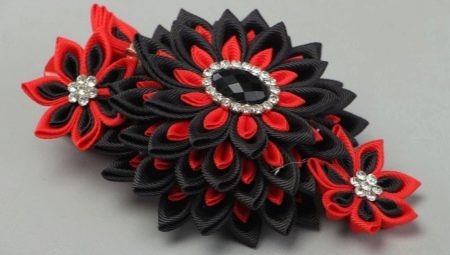
In order for the hairstyle to look neat, women use all kinds of hairpins and hairpins. You can create the most beautiful accessories with your own hands using the kanzashi technique.
In our article, we will dwell in more detail on the process of making stylish accessories.

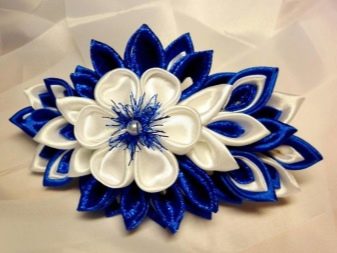
Peculiarities
Kanzashi-style hairpins first appeared in Japan at the beginning of the 17th century; they looked like hairpins and were decorated with expensive ornaments; ribbon compositions were given pride of place. Nowadays, this type of applied art has not lost its relevance.
A do-it-yourself kanzashi-style hairpin is easy to make. As a rule, inexperienced craftswomen begin work by creating the simplest compositions, folding small bows from braid and attaching them to a simple elastic band. Needlewomen with experience make more complex compositions: voluminous bouquets, butterflies, dragonflies, ladybirds, school models are of particular interest.
Keep in mind: despite the fact that kanzashi technology is simple, nevertheless it will take a lot of time, because to make each hair clip, you have to fold several dozen petals.
However, on the way out, you will receive an exclusive piece of jewelry that will adorn both the little princess and the matured girl.
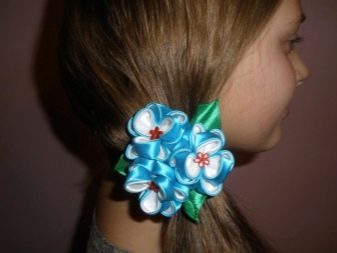
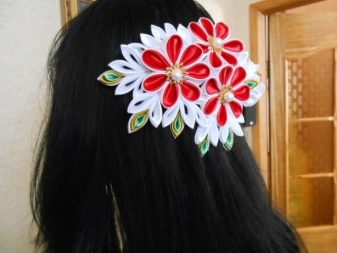
Tools and materials
Hairpins for curls using the kanzashi technique are made from any available components, although if desired, ready-made kits for collecting crafts can be purchased in needlework stores.
For work you will need:
- base for the craft;
- stones, buttons, beads or beads - they are necessary to decorate floral elements;
- any decorative items in the form of grass, cones, stamens or petals;
- satin ribbons of various widths;
- strips of rep or organza.
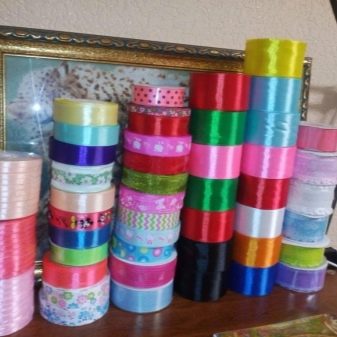
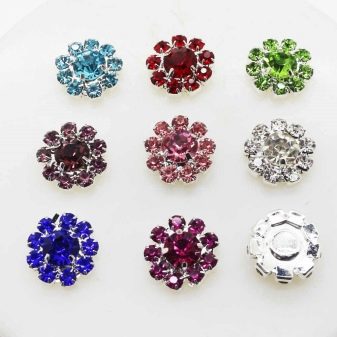
From the tools you should prepare:
- glue / glue gun;
- pointed tweezers;
- small pliers;
- needles of several sizes;
- ruler or centimeter.
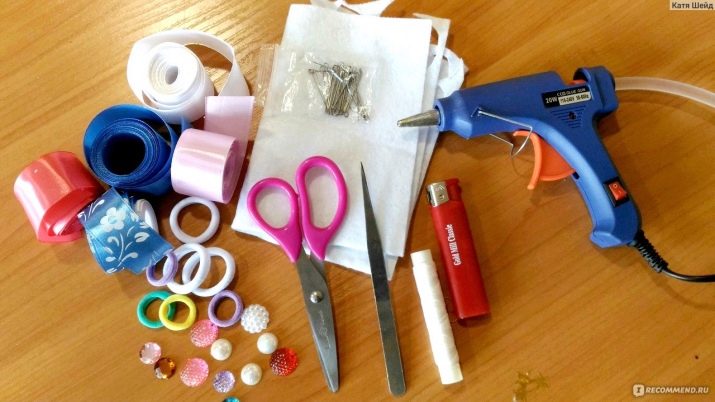
Interesting ideas
We offer you the best master classes on creating unusual voluminous kanzashi hairpins - here you will find step-by-step instructions for both novice craftswomen and experienced needlewomen.
Flower
It is best to start your acquaintance with the kanzashi technique by creating a flower hair clip. For work, you will need a braid of two different colors 4 cm and 5 cm wide: 8 squares of 5x5 cm are formed from the wide one, 13 blanks of 4x4 cm are made from the narrow one.
- Small elements are laid out diagonally, and the resulting triangle is folded two more times. The edges are cut off and scorched with a lighter so that the material does not creep. In this way, 13 blanks are folded.
- The resulting petals are planted on a thread in such a way as to form a flower. To make the structure stronger, you need to cut a small circle from the tape of the same color and stick it on the back.
- Next, you need to roll the second type of roses from 8 petals of a different shade and connect both flowers.
- To decorate the middle, use a stone or a large bead.
This completes the decoration - all you have to do is attach the resulting composition to a hoop or an automatic hair clip.
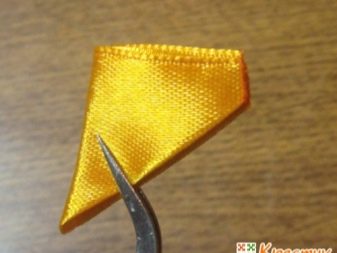
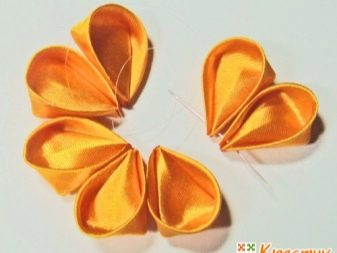

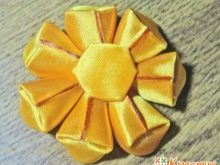
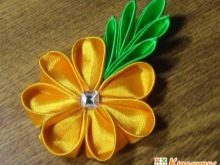
Ice cream
To decorate ice cream decorations you will need wide satin ribbons of snow-white, yellow, and mustard shades, as well as mother-of-pearl half-beads, a yellow cut and a pale green cabochon.
- To begin with, the ribbons are cut into equal lengths of 5x5 cm. To create an ice cream cup using the kanzashi technique, you will need 9 mustard, 10 white and 5 yellow blanks.
- The yellow blank must be folded so that a triangle is formed.
- While holding the corner of the element with your fingers, carefully tuck both sides of the triangle. Continuing to support the edge of the element, it needs to be bent twice again, focusing on the fold stripes.
- The corners that you pinched with your fingers should be carefully cut. After all the actions, you will have a new multi-layer element - it should be scorched over a flame so that all the edges are fused together.
- Measure 4 mm from the bend and cut off all the remnants of the satin ribbon with scissors.
- The resulting sections are scorched again - this allows you to strengthen the craft and prevent shedding.
- The element is ready - the same petals should be made from all the other blanks.
- White and yellow elements can be postponed for a while - work should be started immediately with mustard blocks.
- Take tweezers and pinch the edges of the petal 1-1.5 mm with them, melt the rest of the fabric. Then, stepping back 5–7 mm, make another clamp. It is imperative to ensure that they are located symmetrically. As a result, the module takes on a triangular shape. All other mustard shades are processed in the same way.
- The resulting elements are collected in an ice cream cone. It is formed from three rows. To form the first, two parts are glued together, fastening them with the side parts so that the pointed edges are directed in different directions: one up, the second down. After that, a third workpiece is attached, it is also fixed along the lateral line. The second row is assembled in the same way, only the number of parts used is greater here - 5 elements.
- After that, the finished rows need to be connected to each other, and at the end of the work on the first row, place one blank to give the hairpin the shape of a horn.
- White petals are folded in a semicircle and fixed along the wide edge of the glass.
- A small fan is formed from the yellow blanks, combining all 5 elements. The resulting piece is attached over the white petals - thus, ice cream is obtained.It should be turned with the wrong side up, outline the outline and cut out the corresponding size from yellow felt - it is glued to the bottom of your ice cream.
This will create an effective design for the accessory and fix all the places where the petals accumulate.
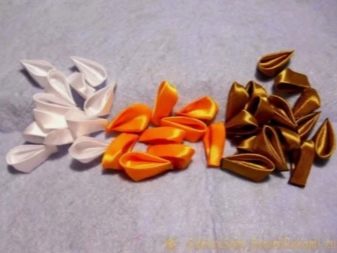
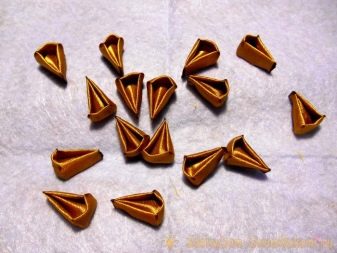
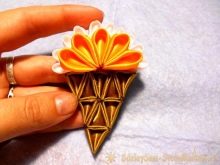
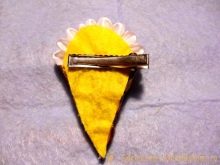
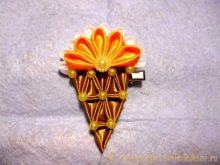
Butterfly
The kanzashi butterfly is made from simple rounded and pointed petals. For work, you will need 20 cm of satin, as well as a 5 cm wide brocade ribbon and accessories for decoration with a set of standard tools.
- All details are made from squares of tape - you need 4 squares of each shade.
- First, you need to make a double sharp wing - for this purpose, the brocade braid is folded diagonally, and then folded in half again.
- The resulting triangle is folded in half again and a petal is formed - its edges should be cut and burned over the fire.
- The second layer is formed in the same way, folding triangles from a satin material.
- To make a butterfly, you will need a couple of sheets of each type. The jewelry is fixed on a wide invisibility, a large stone is inserted into the center.
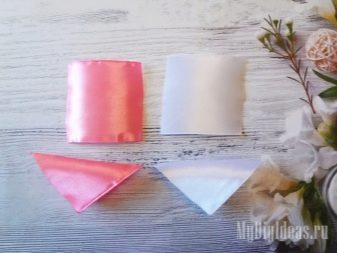
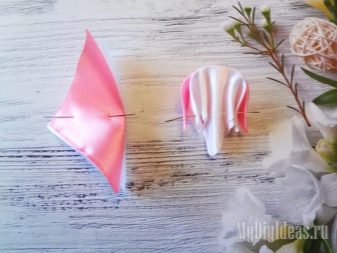
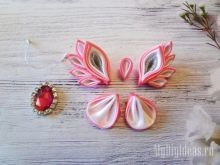
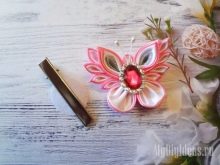

Bouquet of tulips
To create the Tulip Bouquet hair clip, you need a silver brocade ribbon 2.5 cm wide, a white satin ribbon 2.5 cm wide, as well as ready-made stamens with large beads at the edges.
Jewelry creation includes several steps.
- To begin with, you should prepare 10 cm long segments - they are used to twist tulip buds. There are 6 such elements.
- Further, they form segments with a length of 6 cm - they will go to the manufacture of outer petals, they also need 6 pieces.
- After that, you can proceed directly to creating a flower: one long piece is melted with a lighter at the cut points, after which the parts are placed horizontally in front of them, with their back side up. The corner of the left edge is bent towards the edge line, the resulting corner is folded in half again.
- A neat stitch is formed with a needle and thread, consisting of small stitches, it should be laid starting from the edge of the corner. The stitching should run along the entire element, not reaching the edge of 2 mm.
- The second singed edge of the square segment should also be rolled up and all the steps should be completely repeated, only on the other side. Without cutting the threads, the line is pulled together a little, forming a couple of bartacks.
- Starting from the corner, the segment is carefully twisted into a soft tube, the position of the tape is fixed with a needle and thread. The result is a small bud - the same blanks must be made from the remaining 5 long segments.
- Petals are formed from small segments. To do this, each part is placed in front of you and the corners are tucked on both sides. Holding the workpiece in this position with a needle, they make a simple stitch along the entire strip, at the end of the line it is necessary to pull together and make several knots so that the petal can maintain its shape.
- The resulting petal is fixed with glue over one of the buds.
Do the same with all the other blanks - the result is beautiful tulip flowers.

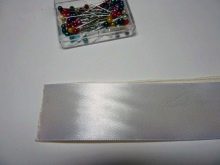

Jellyfish
Little girls will surely love the ribbon hairpin, which looks like a jellyfish in its appearance. Making such a bow is not difficult at all.
You need to prepare:
- narrow satin ribbon 6 mm;
- 2 felt mugs with a diameter of 4 cm.
Foil and wooden skewers are also useful in the work.
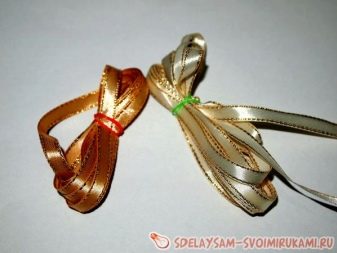

A jellyfish hairpin is assembled from two main blocks - a fluff, formed from small pieces of satin ribbon, and elongated spirals.
- To begin with, they take a satin braid of two close shades and cut it into 6 cm segments - 6 such segments are needed for one hairpin.
- Long pieces of tape 25–26 cm long are also useful, about 10 pieces will be needed for one hair clip.
- Further, spirals are rolled up from the ribbons - for this purpose, long segments should be wound on skewers and fixed around the edges with foil. The resulting workpiece is wrapped in foil again and placed in an oven or microwave oven for 15 minutes. When the foil has cooled, the tapes are carefully removed - you get tight spirals.
- Loops are made from the cuts of the tape by 6 cm. To do this, their edges are fastened together and, gently supporting with tweezers, are melted over a candle for fastening. The same manipulations are carried out with all other blanks.
- After that, 14 petals are glued to the felt part around the circumference, they must be placed as close to each other as possible. Gradually, it is necessary to fill the entire base with loops in a circle, usually about 6 rows are obtained. To hide a small hole in the middle, connect 5 loops and fasten.
- After that, the workpiece is turned over and another row of loops is glued, spirals folded in half are attached from one edge.
- Further, it remains only to fasten the second felt circle on top and the hairpin is ready.
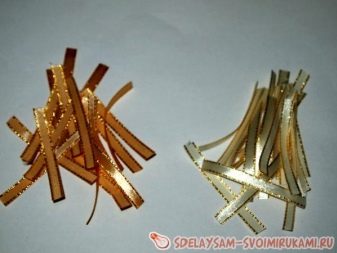
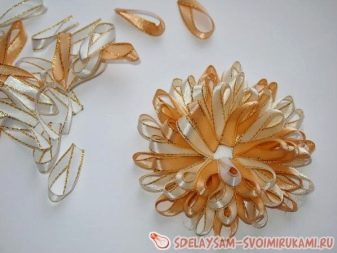
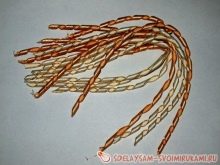
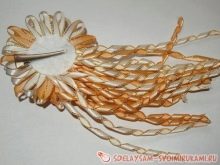

Dragonflies
Another interesting option for a kanzashi accessory is a dragonfly.
- MK traditionally begins with cutting the braid into squares. Then, from the ribbons of a white shade, round petals should be formed. After that, the workpieces are bent obliquely, and the sharp corner of the resulting triangle is carefully wrapped to the center of the right corner. This element is fixed along the central line, the excess tape is cut off, and the sections of the cuts are certainly scorched. At the exit, a round petal is formed - wings will be formed from it, you will need 4 blanks.
- To form the body, you need to make a sharp-shaped petal - the square cut is folded in half several times, the corner is cut off and scorched over the fire. You will need 3 such elements.
Attach the body on top and decorate the dragonfly with beads.
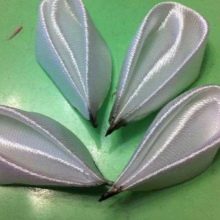

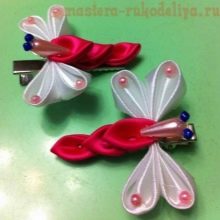
Recommendations
Depending on the characteristics of the future hair clip, you can take a variety of bases. They are of several types:
- with an automatic fastening mechanism that is able to withstand a large amount of strands - decorating such an accessory will require creating a large composition so that it can hide a massive base behind it;
- invisible ones with a click-gag mechanism - they fix small strands;
- hairpins made of high strength metal - usually they are decorated with beads or foamiran;
- hair wreath or hoop;
- any metal base from unnecessary strand clamp.
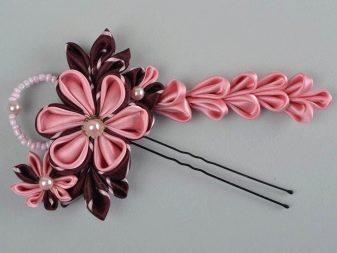
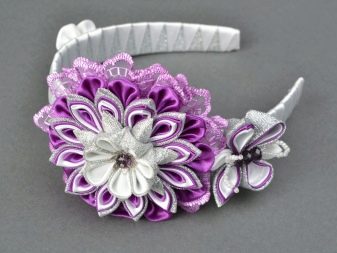
Beautiful works
We offer you a small selection of the most stylish kanzashi-style hairpins:
- children's hairpins look very nice;

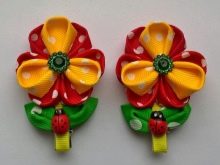
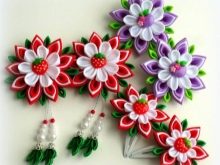
- many interesting solutions are offered for the school;
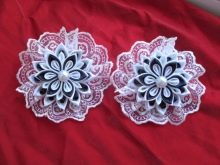


- novelties from foamiran look spectacular and unusual;

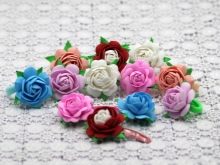

- for adult girls, you can also pick up interesting options.
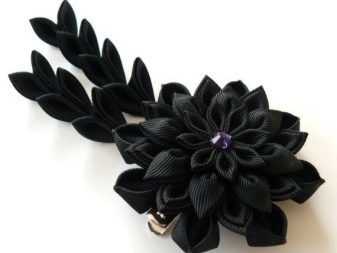
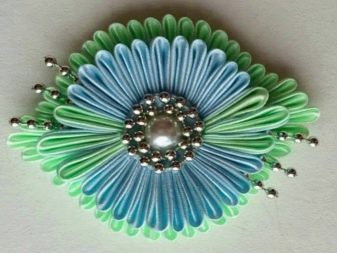
For a master class on making hairpins using the kanzashi technique, see the next video.







